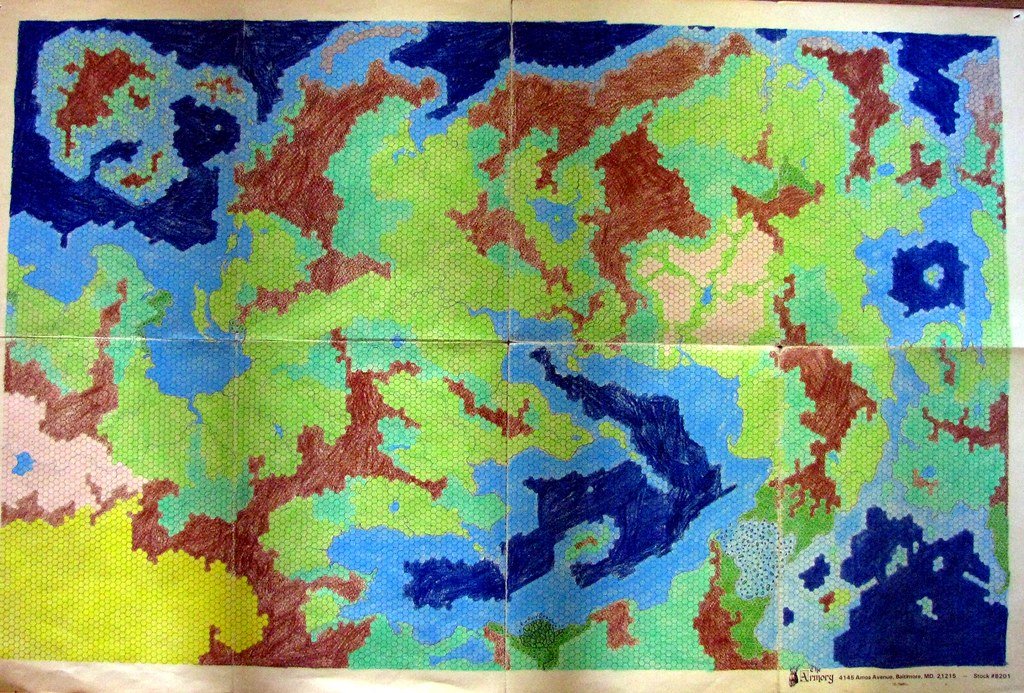Now Reading: The Best Maps for Outdoor Survival
-
01
The Best Maps for Outdoor Survival
The Best Maps for Outdoor Survival
As the sun ascends over the rugged landscape, casting a golden hue upon the towering peaks and dense forests, an explorer’s heart yearns to wander the untamed wilderness. But in this vast expanse of nature’s wonders, where GPS signals fade away like whispers on the wind, the art of navigation becomes an indispensable skill, a lifeline for fearless adventurers. As ancient as humanity itself, maps have been our trusted companions, guiding us through uncharted territories and graciously unfolding the secrets of the world. Today, with technology at our fingertips, choosing the best maps for outdoor survival is akin to unveiling a treasure trove of essential knowledge. So, let us embark on a pictorial odyssey, uncovering the most remarkable cartographic gems that will lead us through unexplored realms and forge our path in the wilderness.
Table of Contents
- Mapping Your Way to Survival: The Ultimate Guide to Choosing the Best Outdoor Maps
- Exploring the Terrain: Understanding the Topographic Features of Reliable Survival Maps
- Navigating the Wilderness: Essential Features to Look for in Outdoor Survival Maps
- Charting Your Course: Expert-Recommended Maps for Optimal Outdoor Navigation
- Compass & Cartography: Finding the Perfect Balance Between Digital and Paper Maps
- Q&A
- In Conclusion

Mapping Your Way to Survival: The Ultimate Guide to Choosing the Best Outdoor Maps
When it comes to venturing into the great outdoors, having a reliable map is essential. Whether you’re an avid hiker, a seasoned mountaineer, or a weekend adventurer, choosing the right outdoor map can make all the difference in ensuring your safety and success.
So, how do you go about finding the best outdoor map for your needs? Here are a few factors to consider:
- Scale: The scale of a map determines its level of detail. For more remote or rugged terrains, a larger scale map with greater detail may be necessary. On the other hand, if you’re exploring a well-marked trail or a popular area, a smaller scale map may suffice.
- Topography: Look for maps that accurately depict the terrain you’ll encounter. Contour lines, elevation markers, and shading can provide valuable information about slopes, peaks, and other features that can impact your journey.
- Durability: Outdoor maps are subject to the elements, so choose one that is waterproof, tear-resistant, and able to withstand the wear and tear of your adventures.
Additionally, consider the type of map that suits your needs. Topographic maps provide detailed geographical information, while trail maps focus specifically on hiking and biking routes. Some maps even come with additional features such as GPS coordinates, landmarks, or historical information.
Taking the time to carefully select the best outdoor map for your specific adventure can greatly enhance your experience and ensure you stay on the right track. Remember, your map is not only a tool for navigation but also a valuable companion that can help you unlock the wonders of the great outdoors.

Exploring the Terrain: Understanding the Topographic Features of Reliable Survival Maps
There is more to survival maps than meets the eye. These intricate navigational tools are designed to provide critical information about the terrain to increase your chances of survival in outdoor environments. By understanding the topographic features portrayed on these maps, you can navigate with confidence and make informed decisions.
Topographic lines, a fundamental element of survival maps, represent the elevation and steepness of the land. In order to traverse rugged terrains, it is essential to identify areas with high relief, indicated by closely spaced contour lines. These contour lines also reveal ridge lines, peaks, and valleys. Paying attention to these features can help you determine the best routes to take and avoid hazardous paths.
Water bodies are another key element to consider. Survival maps often display lakes, rivers, and streams, which are vital for sustenance and navigation. Bold, blue lines indicate sizable water bodies, while lighter, narrower lines represent smaller streams. Be aware that water sources might be seasonal, so having this knowledge can help you plan your journey and ensure access to life-sustaining resources.
Furthermore, man-made features such as roads, trails, and landmarks can be invaluable when navigating unfamiliar territories. Survival maps often include symbols or icons to represent these human-made elements. Familiarize yourself with these symbols to easily identify paths and potential points of interest or resources nearby.
By honing your understanding of the topographic features portrayed on survival maps, you unlock the ability to decipher essential information about the terrain. This knowledge will empower you to navigate efficiently, maximize your safety, and ultimately enhance your chances of survival in the great outdoors. Remember, these maps are your trusted companions – study them well.
Navigating the Wilderness: Essential Features to Look for in Outdoor Survival Maps
When heading into the wilderness, having a reliable outdoor survival map is paramount for your safety and success. These essential features will ensure that you can navigate through unknown terrain with confidence and ease.
1. **Accuracy**: The first and most important feature to look for in an outdoor survival map is accuracy. Ensure that the map is up-to-date and includes accurate topographic information, landmarks, and trails. This will help you pinpoint your location and plan your route effectively.
2. **Durability**: In harsh outdoor conditions, your map needs to withstand wear and tear. Look for maps made from durable materials like waterproof and tear-resistant paper or laminated sheets. This will protect your map from damage caused by water, wind, or rough handling.
3. **User-friendly Design**: An outdoor survival map should be designed with ease of use in mind. Look for clear labeling, symbols, and colors that allow for quick and easy interpretation. A map with a scale, compass rose, and grid system can help you accurately measure distances, determine directions, and navigate with precision.
4. **Detailed Legend**: A well-labeled and comprehensive legend is crucial for understanding the various symbols and markings on the map. Make sure the legend provides clear explanations for contour lines, water features, vegetation, and any other key elements that may affect your navigation in the wilderness.
5. **Portability**: When exploring the wilderness, it’s important to travel light. Choose a map that is compact and easy to carry. Look for options that can be folded conveniently or fit into a protective case or sleeve. This will ensure that you can access your map easily when needed, without adding unnecessary weight to your gear.
By paying attention to these essential features in outdoor survival maps, you’ll be equipped with a reliable tool to navigate the wilderness confidently, increasing your chances of a successful and memorable adventure.
Charting Your Course: Expert-Recommended Maps for Optimal Outdoor Navigation
Expert-Recommended Maps for Optimal Outdoor Navigation
Embarking on an outdoor adventure requires proper planning, and having the right map is crucial for a successful journey. Our team of experts has curated a list of top-notch maps that will guide you through even the most challenging terrains. Whether you are a seasoned hiker, a mountain biker, or a nature enthusiast looking to explore new trails, these expert-recommended maps will ensure that you stay on the right track, saving you time and protecting you from unnecessary detours.
- Trail Maps: When hitting the trails, detailed trail maps are essential for navigation. These user-friendly maps are designed specifically for hikers and backpackers, highlighting critical landmarks, campsites, water sources, and difficulty levels. With well-marked routes and elevation profiles, you can confidently venture into the wilderness.
- Topographic Maps: For the more adventurous souls, topographic maps are a must-have. These maps provide in-depth information on the landscape, including contour lines, elevation, and land features. Armed with this knowledge, you can conquer mountains, conquer rivers, and truly immerse yourself in the beauty of nature.
- Specialized Maps: When exploring specific outdoor activities such as rock climbing, kayaking, or skiing, specialized maps come to the rescue. These maps cater to the unique needs of each activity, ensuring that you have accurate information about cliffs, rapids, or ski slopes, allowing you to make informed decisions and stay safe throughout your adventure.
Remember, a well-chosen map is like a reliable compass, enabling you to navigate uncharted territories with confidence and ease. So, before you embark on your next outdoor escapade, make sure to grab one of these expert-recommended maps and chart your course like a pro!
Compass & Cartography: Finding the Perfect Balance Between Digital and Paper Maps
When it comes to navigating the world, there is a timeless debate between digital and paper maps. Each have their own advantages and disadvantages, and finding the perfect balance between the two can make all the difference.
Benefits of Digital Maps:
- Real-Time Updates: Digital maps provide the advantage of real-time updates, ensuring accurate information about roads, traffic, and points of interest. They can help you navigate unfamiliar areas with ease.
- Convenience: Carrying a digital map in your pocket on a smartphone or tablet is much more convenient than lugging around a physical map. With a simple tap, you can access maps, directions, and additional information anytime, anywhere.
- Interactive Features: Digital maps often come with interactive features, such as zooming, satellite imagery, and street view, which enhance your navigation experience and allow you to explore places virtually before reaching them.
Advantages of Paper Maps:
- Tactile Experience: There is something magical about unfolding a paper map and feeling the texture of the paper. It offers a tactile experience that technology cannot replicate, allowing you to engage with the map in a more intimate and hands-on manner.
- Reliability: Paper maps do not rely on batteries or an internet connection, making them a reliable backup in case your digital device fails or you find yourself in an area with no signal.
- Big Picture Perspective: With a physical map spread out in front of you, you can easily visualize the entire area, plan your route, and understand the geographical context in a way that digital maps often cannot replicate.
So, is there a definitive winner in the compass and cartography battle? Not really. The perfect balance lies in utilizing the strengths of both digital and paper maps. Incorporating technology for real-time updates and convenience while keeping a trusty paper map as a backup ensures you’re always prepared, no matter the circumstances.
Q&A
What are some essential maps for outdoor survival?
Some essential maps for outdoor survival include topographic maps, which show the terrain and elevation; navigation charts, which provide nautical information; and wilderness maps, which highlight trails and campgrounds.
How can topographic maps help with outdoor survival?
Topographic maps are crucial for outdoor survival as they provide detailed information about the shape and elevation of the land, helping adventurers identify potential hazards, locate water sources, and plan safe routes.
What should I look for when choosing a navigation chart for outdoor adventures?
When selecting a navigation chart, it is important to consider accurate representation of water depth, markers for navigation aids, warning symbols for hazards, and any updates or revisions available to ensure reliable maritime navigation.
What makes wilderness maps helpful for outdoor survival?
Wilderness maps are indispensable for outdoor survival due to their focus on areas with little to no development. They typically provide information on trailheads, landmarks, natural features, and campgrounds, making them ideal for hikers and backpackers.
Are there any digital maps that can be used for outdoor survival?
Yes, there are several digital maps that can be used for outdoor survival, such as GPS-enabled apps and online mapping services. These tools offer various features like real-time location tracking, route planning, and even offline access for remote areas.
What are some common symbols found on survival maps?
Common symbols found on survival maps include those representing landmarks, rivers, lakes, mountains, trails, campgrounds, and different types of vegetation. These symbols help users navigate and interpret the map more efficiently.
Can I create my own survival maps?
Certainly! Creating your own survival maps can be a fun and useful endeavor. Start by gathering accurate information and using a scale that suits your purpose. Add essential symbols, labels, and a legend to ensure the map is easy to understand and navigate.
How often should I update my survival maps?
It is recommended to update your survival maps regularly, especially if you frequently visit a specific area or if there have been recent changes in the landscape or trail conditions. Keeping your maps up to date ensures accurate information for a successful outdoor adventure.
Are there any additional resources to complement survival maps?
Yes, there are additional resources that complement survival maps, such as compasses, GPS devices, and guidebooks. These tools can provide further assistance and enhance your outdoor survival experience when used in combination with maps.
In Conclusion
As we conclude our exploration of the best maps for outdoor survival, we are reminded of the profound way in which these navigational tools connect us to the vast and mysterious world that lies beyond our urban jungles. From the towering peaks of untouched mountains to the dense foliage of bewildering forests, these maps hold the key to unlocking the secrets of Mother Nature’s kingdom.
Amidst the chaos of our modern lives, the allure of nature’s raw beauty and untamed wilderness beckons us forward. It is within these moments of solitude, surrounded by nature’s symphony, that we realize our true connection to the Earth. And what better companion can we have on this journey of exploration than a reliable map?
With each scratch of pencil, contour line traced, or grid square studied, we are embarking on a quest of self-discovery and resilience. With the right map in hand, even the daunting reaches of unexplored territories can become familiar haunts, our compass guiding us towards safety and salvation.
But it’s not just the physicality of these maps that captivates us. Their presence invokes a profound sense of wonder, reminding us that the world is far greater than the limits of our individual perspective. Every fold in the paper, every crease representing the countless journeys it has been a part of, serves as a testament to the strength of human curiosity.
So, dear adventurers, as you venture forth into the wilderness, remember that the maps we choose to accompany us are more than mere diagrams of land and sea. They are conduits to the unknown, bridges connecting us to the untamed realms awaiting our footsteps.
With the best maps for outdoor survival in your possession, may you find not only your way but also a deeper understanding of the world around you. Embrace the challenges that come your way, for it is through these moments that we truly experience the beauty of survival in the great outdoors.
So, grab your backpack, secure those laces, and set forth with confidence. Let the whispered secrets of the trees and the distant echoes of rushing rivers guide you, while your trusty map leads the way. And remember, in every step you take, you are part of a story that is unfolding in the grand tapestry of nature. Embark on your journey, for the best maps are waiting to unveil the hidden wonders of our majestic planet.
As an affiliate, my content may feature links to products I personally use and recommend. By taking action, like subscribing or making a purchase, you’ll be supporting my work and fueling my taco cravings at the same time. Win-win, right?
Want to read more? Check out our Affiliate Disclosure page.


